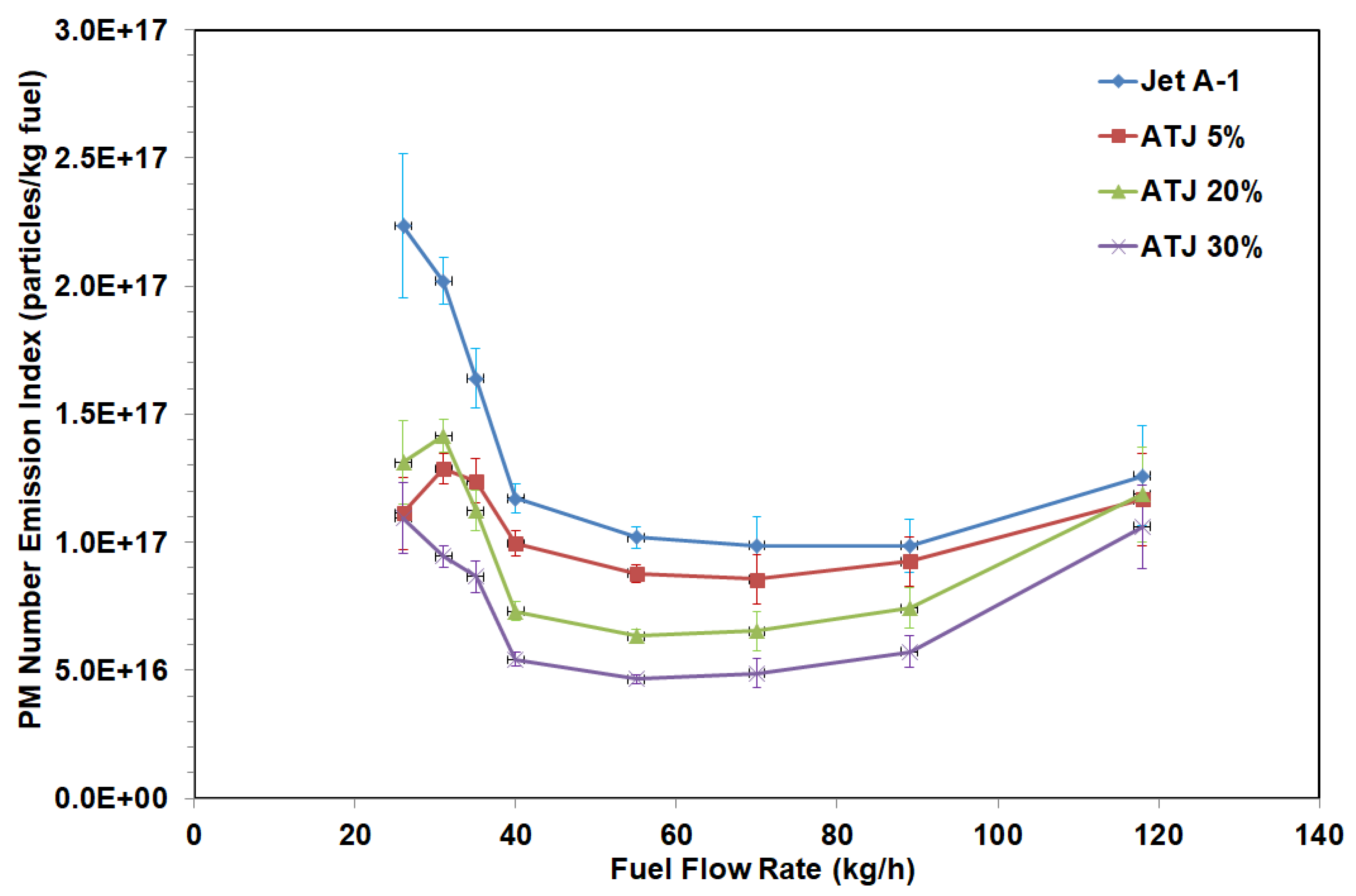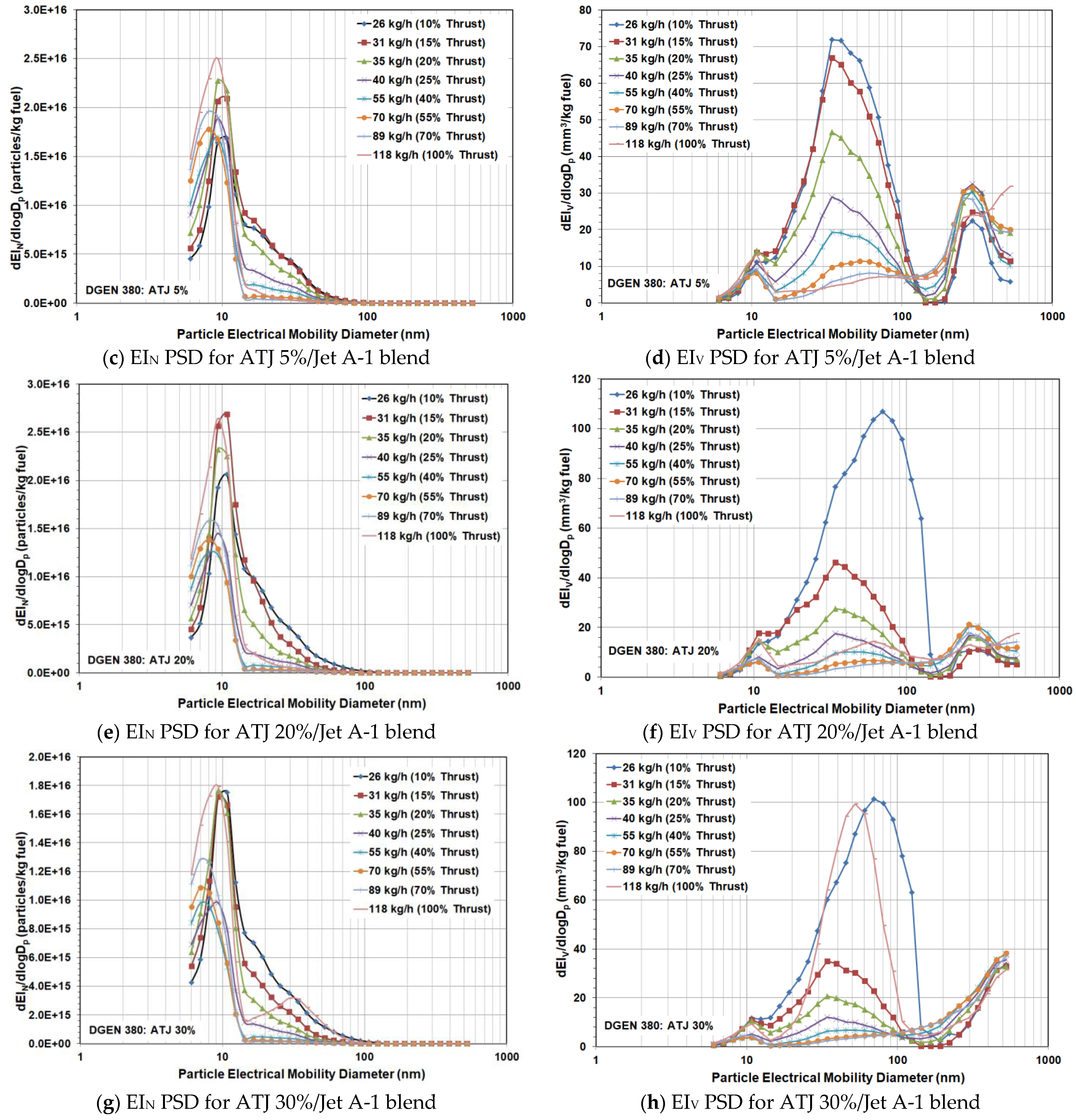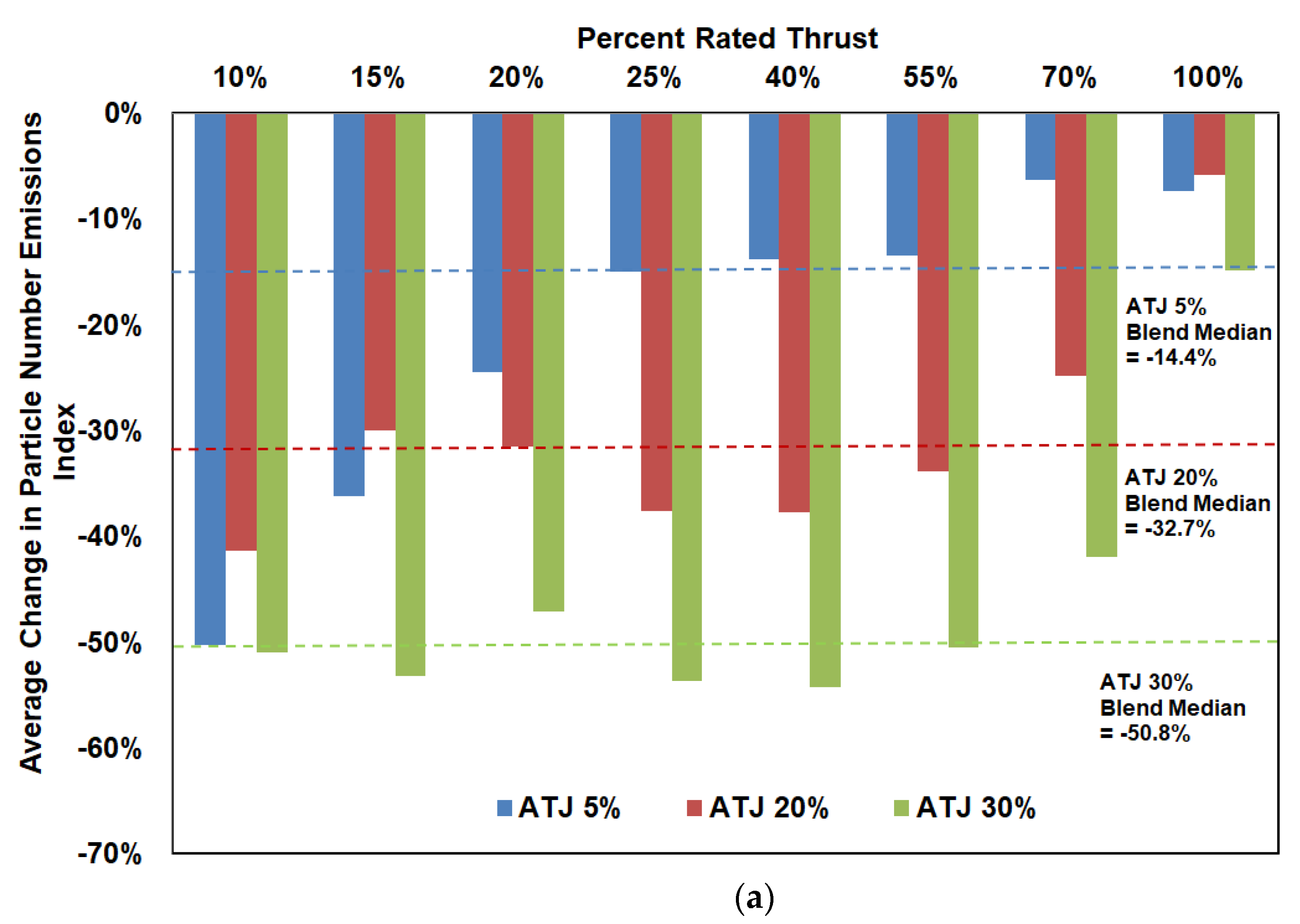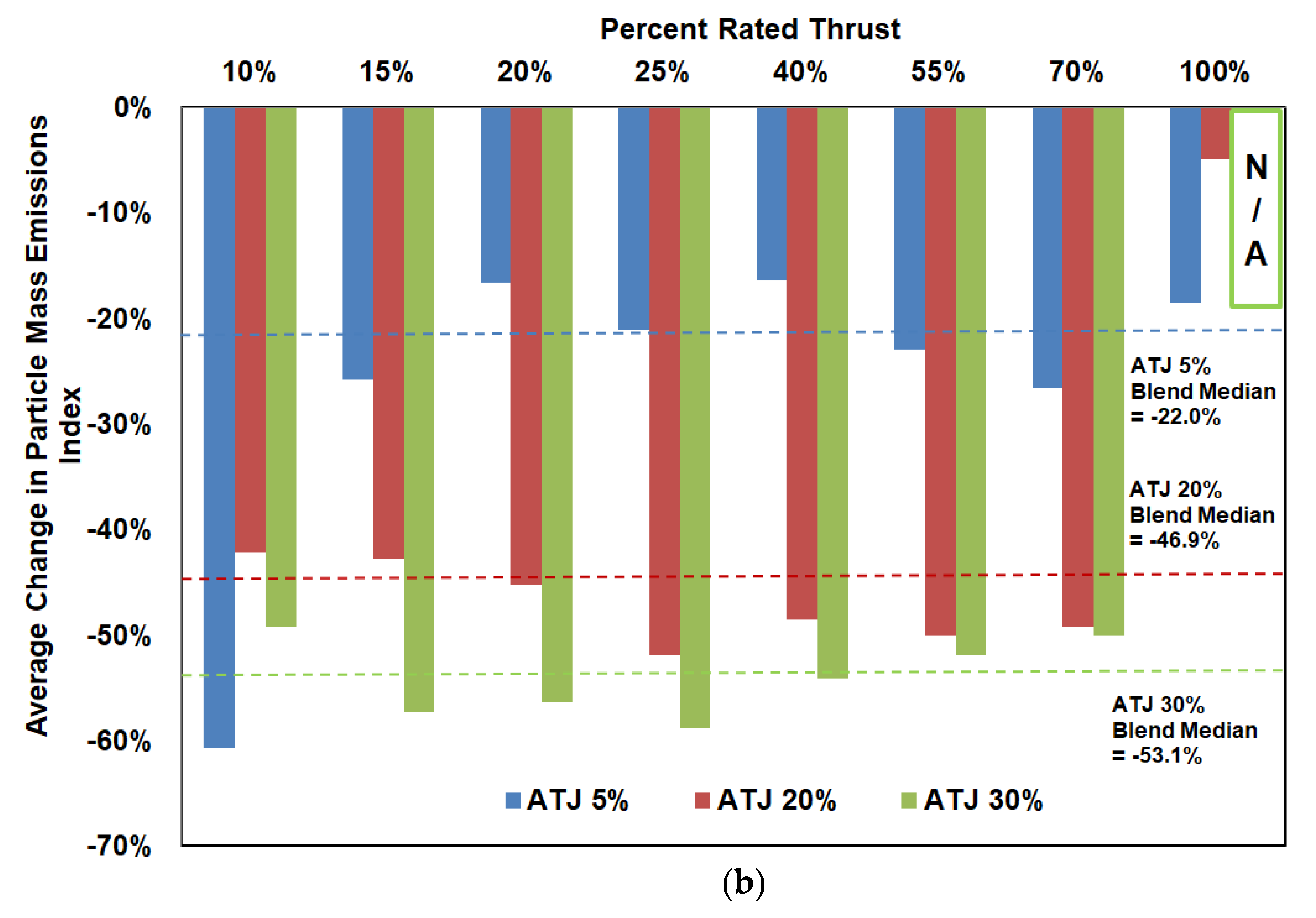Characterization of Particle Emissions from a DGEN 380 Small Turbofan Fueled with ATJ Blends
Abstract
1. Introduction
2. Materials and Methods
2.1. Test Engine, Fuels, Operating Schedule
2.2. Apparatus and Procedures
2.3. Data Analyses
3. Results
3.1. Particle Number Emission Indices
3.2. PM Mass Emission Indices
3.3. Particle Size Distribution
4. Discussion
5. Conclusions
Author Contributions
Funding
Acknowledgments
Conflicts of Interest
References
- IRENA. Biofuels for Aviation, Technology Brief; International Renewable Energy Agency: Abu Dhabi, United Arab Emirates, 2017. [Google Scholar]
- Bosch, J.; Hoefnagels, R.; Jong, S.; Slade, R. Aviation Biofuels: Strategically Important, Technically Achievable, Tough to Deliver; Grantham Institute, Imperial College London: London, UK, 2017. [Google Scholar]
- Starck, L.; Pidol, L.; Jeuland, N.; Chapus, T.; Bogers, P.; Bauldreay, J. Production of Hydroprocessed Esters and Fatty Acids (HEFA)—Optimisation of Process Yield. Oil Gas Sci. Technol. Rev. de l’IFP 2014, 71. [Google Scholar] [CrossRef]
- Capaz, R.S.; de Medeiros, E.M.; Falco, D.G.; Seabra, J.E.; Osseweijer, P.; Posada, J.A. Environmental trade-offs of renewable jet fuels in Brazil: Beyond the carbon footprint. Sci. Total Environ. 2020, 714, 136696. [Google Scholar] [CrossRef] [PubMed]
- Chen, L.; Gao, K.; Zhang, C.; Lang, W. Alternative fuels for IC engines and jet engines and comparison of their gaseous and particulate matter emissions. In Advanced Biofuels; Woodhead Publishing: Sawston, UK, 2019; pp. 17–64. [Google Scholar]
- Burkhardt, U.; Kärcher, B. Global radiative forcing from contrail cirrus. Nat. Clim. Chang. 2011, 1, 54–58. [Google Scholar] [CrossRef]
- Jasinski, R. Estimation of particles emissions from a jet engine in real flight. E3S Web Conf. 2019, 100, 00029. [Google Scholar] [CrossRef]
- World Health Organization. Health Effects of Particulate Matter. Policy Implications for Countries in Eastern Europe; Caucasus and Central Asia; World Health Organization: Geneva, Switzerland, 2013; Available online: https://www.euro.who.int/__data/assets/pdf_file/0006/189051/Health-effects-of-particulate-matter-final-Eng.pdf (accessed on 9 April 2021).
- Lee, D.; Pitari, G.; Grewe, V.; Gierens, K.; Penner, J.; Petzold, A.; Prather, M.; Schumann, U.; Bais, A.; Berntsen, T. Transport impacts on atmosphere and climate: Aviation. Atmos. Environ. 2010, 44, 4678–4734. [Google Scholar] [CrossRef]
- Yim, S.H.L.; Lee, G.L.; Lee, I.H.; Allroggen, F.; Ashok, A.; Caiazzo, F.; Eastham, S.D.; Malina, R.; Barrett, S.R.H. Global, regional and local health impacts of civil aviation emissions. Environ. Res. Lett. 2015, 10, 34001. [Google Scholar] [CrossRef]
- Burnett, R.; Chen, H.; Szyszkowicz, M.; Fann, N.; Hubbell, B.; Pope, C.A.; Apte, J.S.; Brauer, M.; Cohen, A.; Weichenthal, S.; et al. Global estimates of mortality associated with long-term exposure to outdoor fine particulate matter. Proc. Natl. Acad. Sci. USA 2018, 115, 9592–9597. [Google Scholar] [CrossRef]
- Quadros, F.D.A.; Snellen, M.; Dedoussi, I.C. Regional sensitivities of air quality and human health impacts to aviation emissions. Environ. Res. Lett. 2020, 15, 105013. [Google Scholar] [CrossRef]
- Lobo, P.; Durdina, L.; Brem, B.T.; Crayford, A.P.; Johnson, M.P.; Smallwood, G.J.; Siegerist, F.; Williams, P.I.; Black, E.A.; Llamedo, A.; et al. Comparison of standardized sampling and measurement reference systems for aircraft engine non-volatile particulate matter emissions. J. Aerosol Sci. 2020, 145, 105557. [Google Scholar] [CrossRef]
- European Comission. Research of Aviation PM Technologies, Modelling and Regulation. Available online: https://cordis.europa.eu/project/id/863969 (accessed on 26 April 2021).
- Archilla, V.; Hormigo, D.; Sánchez-García, M.; Raper, D. AVIATOR—Assessing aViation emission Impact on local Air quality at airports: TOwards Regulation. MATEC Web Conf. 2019, 304, 02023. [Google Scholar] [CrossRef][Green Version]
- Moore, R.H.; Shook, M.; Beyersdorf, A.; Corr, C.; Herndon, S.; Knighton, W.B.; Miake-Lye, R.; Thornhill, K.L.; Winstead, E.L.; Yu, Z.; et al. Influence of Jet Fuel Composition on Aircraft Engine Emissions: A Synthesis of Aerosol Emissions Data from the NASA APEX, AAFEX, and ACCESS Missions. Energy Fuels 2015, 29, 2591–2600. [Google Scholar] [CrossRef]
- Brem, B.T.; Durdina, L.; Siegerist, F.; Beyerle, P.; Bruderer, K.; Rindlisbacher, T.; Rocci-Denis, S.; Andac, M.G.; Zelina, J.; Penanhoat, O.; et al. Effects of Fuel Aromatic Content on Nonvolatile Particulate Emissions of an In-Production Aircraft Gas Turbine. Environ. Sci. Technol. 2015, 49, 13149–13157. [Google Scholar] [CrossRef]
- Moore, R.H.; Thornhill, K.L.; Weinzierl, B.; Sauer, D.; D’Ascoli, E.; Kim, J.; Lichtenstern, M.; Scheibe, M.; Beaton, B.; Beyersdorf, A.J.; et al. Biofuel blending reduces particle emissions from aircraft engines at cruise conditions. Nat. Cell Biol. 2017, 543, 411–415. [Google Scholar] [CrossRef]
- Lobo, P.; Condevaux, J.; Yu, Z.; Kuhlmann, J.; Hagen, D.E.; Miake-Lye, R.C.; Whitefield, P.D.; Raper, D.W. Demonstration of a Regulatory Method for Aircraft Engine Nonvolatile PM Emissions Measurements with Conventional and Isoparaffinic Kerosene fuels. Energy Fuels 2016, 30, 7770–7777. [Google Scholar] [CrossRef]
- Kinsey, J.S.; Squier, W.; Timko, M.T.; Dong, Y.; Logan, R. Characterization of the Fine Particle Emissions from the Use of Two Fischer–Tropsch Fuels in a CFM56-2C1 Commercial Aircraft Engine. Energy Fuels 2019, 33, 8821–8834. [Google Scholar] [CrossRef]
- Jürgens, S.; Oßwald, P.; Selinsek, M.; Piermartini, P.; Schwab, J.; Pfeifer, P.; Bauder, U.; Ruoff, S.; Rauch, B.; Köhler, M. Assessment of combustion properties of non-hydroprocessed Fischer-Tropsch fuels for aviation. Fuel Process. Technol. 2019, 193, 232–243. [Google Scholar] [CrossRef]
- Kurzawska, P.; Jasiński, R. Overview of Sustainable Aviation Fuels with Emission Characteristic and Particles Emission of the Turbine Engine Fueled ATJ Blends with Different Percentages of ATJ Fuel. Energies 2021, 14, 1858. [Google Scholar] [CrossRef]
- Przysowa, R.; Gawron, B.; Białecki, T.; Łęgowik, A.; Merkisz, J.; Jasiński, R. Performance and Emissions of a Microturbine and Turbofan Powered by Alternative Fuels. Aerospace 2021, 8, 25. [Google Scholar] [CrossRef]
- ICAO. Sustainable Aviation Fuels Guide; International Civil Aviation Organization: Montreal, QC, Canada, 2018. [Google Scholar]
- Chiaramonti, D. Sustainable Aviation Fuels: The challenge of decarbonization. Energy Procedia 2019, 158, 1202–1207. [Google Scholar] [CrossRef]
- Zschocke, A.; Scheuermann, S.; Ortner, J. High Biofuel Blends in Aviation (HBBA), ENER/C2/2012/420-1, Final Report; Lufthansa: Cologne, Germany, 2012. [Google Scholar]
- Richter, S.; Braun-Unkhoff, M.; Naumann, C.; Riedel, U. Paths to alternative fuels for aviation. CEAS Aeronaut. J. 2018, 9, 389–403. [Google Scholar] [CrossRef]
- Burton, F. LanzaTech is Recognized as an Industry Leader in Bending the Carbon Curve. LanzaTech. Available online: https://www.lanzatech.com/2021/04/23/lanzatech-is-recognized-as-an-industry-leader-in-bending-the-carbon-curve/ (accessed on 9 April 2021).
- Wang, W.-C.; Tao, L. Bio-jet fuel conversion technologies. Renew. Sustain. Energy Rev. 2016, 53, 801–822. [Google Scholar] [CrossRef]
- Tran, S.; Brown, A.; Olfert, J.S. Comparison of Particle Number Emissions from In-Flight Aircraft Fueled with Jet A1, JP-5 and an Alcohol-to-Jet Fuel Blend. Energy Fuels 2020, 34, 7218–7222. [Google Scholar] [CrossRef]
- Xue, X.; Hui, X.; Singh, P.; Sung, C.-J. Soot formation in non-premixed counterflow flames of conventional and alternative jet fuels. Fuel 2017, 210, 343–351. [Google Scholar] [CrossRef]
- Schripp, T.; Grein, T.; Zinsmeister, J.; Oßwald, P.; Köhler, M.; Müller-Langer, F.; Hauschild, S.; Marquardt, C.; Scheuermann, S.; Zschocke, A.; et al. Technical application of a ternary alternative jet fuel blend—Chemical characterization and impact on jet engine particle emission. Fuel 2021, 288, 119606. [Google Scholar] [CrossRef]
- Pawlak, M.; Majka, A.; Kuzniar, M.; Pawluczy, J. MODEL OF EMISSION OF EXHAUST COMPOUNDS OF JET AIRCRAFT IN CRUISE PHASE ENABLING TRAJECTORY OPTIMIZATION. Transport 2020, 35, 87–97. [Google Scholar] [CrossRef]
- Pawlak, M.; Kuźniar, M. Determination of CO2 Emissions for Selected Flight Parameters of a Business Jet Aircraft. J. Kones 2019, 26, 155–163. [Google Scholar] [CrossRef]
- Gawron, B.; Białecki, T.; Janicka, A.; Suchocki, T. Combustion and Emissions Characteristics of the Turbine Engine Fueled with HEFA Blends from Different Feedstocks. Energies 2020, 13, 1277. [Google Scholar] [CrossRef]
- DGEN 380 BR Training (Unpublished), Price Induction; Aviation Pros: Atlanta, GA, USA, 2017.
- Berton, J.J. System Noise Prediction of the DGEN 380 Turbofan Engine. J. Aircr. 2016, 53, 1779–1786. [Google Scholar] [CrossRef]
- Durdina, L.; Brem, B.; Abegglen, M.; Lobo, P.; Rindlisbacher, T.; Thomson, K.; Smallwood, G.; Hagen, D.; Sierau, B.; Wang, J. Determination of PM mass emissions from an aircraft turbine engine using particle effective density. Atmos. Environ. 2014, 99, 500–507. [Google Scholar] [CrossRef]
- Kinsey, J.S.; Hays, M.D.; Dong, Y.; Williams, D.C.; Logan, R. Chemical Characterization of the Fine Particle Emissions from Commercial Aircraft Engines during the Aircraft Particle Emissions eXperiment (APEX) 1 to 3. Environ. Sci. Technol. 2011, 45, 3415–3421. [Google Scholar] [CrossRef]
- Timko, M.T.; Fortner, E.; Franklin, J.; Yu, Z.; Wong, H.-W.; Onasch, T.B.; Miake-Lye, R.C.; Herndon, S.C. Atmospheric Measurements of the Physical Evolution of Aircraft Exhaust Plumes. Environ. Sci. Technol. 2013, 47, 3513–3520. [Google Scholar] [CrossRef] [PubMed]
- Timko, M.T.; Onasch, T.B.; Northway, M.J.; Jayne, J.T.; Canagaratna, M.R.; Herndon, S.C.; Wood, E.C.; Miake-Lye, R.C.; Knighton, W.B. Gas Turbine Engine Emissions—Part II: Chemical Properties of Particulate Matter. J. Eng. Gas Turbines Power 2010, 132, 061505. [Google Scholar] [CrossRef]
- Wong, H.-W.; Yelvington, P.E.; Timko, M.T.; Onasch, T.B.; Miake-Lye, R.C.; Zhang, J.; Waitz, I.A. Microphysical Modeling of Ground-Level Aircraft-Emitted Aerosol Formation: Roles of Sulfur-Containing Species. J. Propuls. Power 2008, 24, 590–602. [Google Scholar] [CrossRef]
- Schripp, T.; Anderson, B.E.; Crosbie, E.C.; Moore, R.H.; Herrmann, F.; Oßwald, P.; Wahl, C.; Kapernaum, M.; Köhler, M.; Le Clercq, P.; et al. Impact of Alternative Jet Fuels on Engine Exhaust Composition During the 2015 ECLIF Ground-Based Measurements Campaign. Environ. Sci. Technol. 2018, 52, 4969–4978. [Google Scholar] [CrossRef] [PubMed]
- Rojo, C.; Vancassel, X.; Mirabel, P.; Ponche, J.-L.; Garnier, F. Impact of alternative jet fuels on aircraft-induced aerosols. Fuel 2015, 144, 335–341. [Google Scholar] [CrossRef]
- Jasiński, R.; Pielecha, J. Evaluation of the impact of oil presence in the aviation fuel on particle size distribution. Sci. J. Silesian Univ. Technol. Ser. Transp. 2017, 94, 57–64. [Google Scholar] [CrossRef]
- Lobo, P.; Hagen, D.E.; Whitefield, P.D. Comparison of PM Emissions from a Commercial Jet Engine Burning Conventional, Biomass, and Fischer–Tropsch Fuels. Environ. Sci. Technol. 2011, 45, 10744–10749. [Google Scholar] [CrossRef]
- Chan, T.W.; Canteenwalla, P.; Chishty, W.A. Characterization of Fuel Composition and Altitude Impact on Gaseous and Particle Emissions from a Turbojet Engine. In Proceedings of the ASME Turbo Expo 2017: Turbomachinery Technical Conference and Exposition, Charlotte, NC, USA, 26–30 June 2017; Volume 4A, p. 63131. [Google Scholar] [CrossRef]








| Abbreviation | Process | Raw Material | Approval Date | Blending Limit |
|---|---|---|---|---|
| FT-SPK | Fischer–Tropsch Synthetic Paraffinic Kerosene | Biomass (wood waste, grass, municipal solid waste), natural gas | 2009 | up to 50% |
| HEFA-SPK | Hydroprocessed Esters and Fatty Acids | Oily biomass, e.g., algae, jatropha, camelina, lipids | 2011 | up to 50% |
| HFS-SIP | Hydroprocessed Fermented Sugars to Synthetic Isoparaffins | Bacterial conversion of sugars into hydrocarbons | 2014 | up to 10% |
| FT-SPK/A | FT-SPK with aromatics | Renewable biomass, i.e., municipal solid waste, agricultural and wood waste | 2015 | up to 50% |
| ATJ-SPK | Alcohol-to-Jet Synthetic Paraffinic Kerosene | Agricultural waste (corn shoots, grass, straw), cellulosic biomass, | 2016 | up to 50% |
| CH-SKK or CHJ | Catalytic Hydrothermolysis Synthesized Kerosene | vegetable or animal fats, oils and greases | 2020 | up to 50% |
| HHC-SPK or HC-HEFA-SPK | Hydroprocessed Hydrocarbons, Esters and Fatty Acids Synthetic Paraffinic Kerosene | Hydrocarbons of biological origin, fatty acid esters, free fatty acids, or a species of Botryococcus braunia algae | 2020 | up to 10% |
| Parameter | Value |
|---|---|
| Maximum Thrust | 255 daN |
| Specific Fuel Consumption (for maximum thrust) | 12.4 g/kN·s |
| Bypass ratio | 7.6 |
| Weight | 85 kg |
| Lifetime | 3600 h |
| Test Number | Fuel Type | Average Sample Gas Temperature (°C) | Fuel Flow Rate (l/h) | Tested Percent Rated Thrust Settings (%) |
|---|---|---|---|---|
| 1-pretest, warm | ATJ 0% | 15.4 ± 0.1 | 32, 37, 49, 66, 86, 151 ± 1.5 | 10, 15, 25, 40, 55, 100 ± 2% value |
| 2 | ATJ 0% | 15.9 ± 0.1 | 32, 37, 44, 49, 66, 86, 112, 151 ± 1.5 | 10, 15, 20, 25, 40, 55, 70, 100 ± 2% value |
| 3 | ATJ 5% | 16.1 ± 0.1 | 33, 36, 44, 49, 68, 87, 111, 148 ± 1.5 | 10, 15, 20, 25, 40, 55, 70, 100 ± 2% value |
| 4 | ATJ 20% | 15.8 ± 0.1 | 33, 37, 45, 50, 70, 87, 111, 148 | 10, 15, 20, 25, 40, 55, 70, 100 ± 2% value |
| 5 | ATJ 20% | 15.8 ± 0.1 | 33, 37, 45, 50, 70, 87, 111, 148 | 10, 15, 20, 25, 40, 55, 70, 100 ± 2% value |
| 6 | ATJ 30% | 15.9 ± 0.1 | 33, 36, 44, 50, 69, 87, 112, 148 ± 1.5 | 10, 15, 20, 25, 40, 55, 70, 100 ± 2% value |
| 7 | ATJ 30% | 15.9 ± 0.1 | 33, 36, 44, 50, 69, 87, 112, 148 ± 1.5 | 10, 15, 20, 25, 40, 55, 70, 100 ± 2% value |
Publisher’s Note: MDPI stays neutral with regard to jurisdictional claims in published maps and institutional affiliations. |
© 2021 by the authors. Licensee MDPI, Basel, Switzerland. This article is an open access article distributed under the terms and conditions of the Creative Commons Attribution (CC BY) license (https://creativecommons.org/licenses/by/4.0/).
Share and Cite
Jasiński, R.; Kurzawska, P.; Przysowa, R. Characterization of Particle Emissions from a DGEN 380 Small Turbofan Fueled with ATJ Blends. Energies 2021, 14, 3368. https://doi.org/10.3390/en14123368
Jasiński R, Kurzawska P, Przysowa R. Characterization of Particle Emissions from a DGEN 380 Small Turbofan Fueled with ATJ Blends. Energies. 2021; 14(12):3368. https://doi.org/10.3390/en14123368
Chicago/Turabian StyleJasiński, Remigiusz, Paula Kurzawska, and Radosław Przysowa. 2021. "Characterization of Particle Emissions from a DGEN 380 Small Turbofan Fueled with ATJ Blends" Energies 14, no. 12: 3368. https://doi.org/10.3390/en14123368
APA StyleJasiński, R., Kurzawska, P., & Przysowa, R. (2021). Characterization of Particle Emissions from a DGEN 380 Small Turbofan Fueled with ATJ Blends. Energies, 14(12), 3368. https://doi.org/10.3390/en14123368







